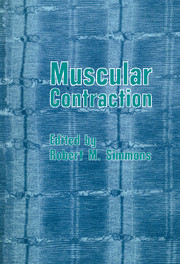Book contents
- Frontmatter
- Contents
- Dedication
- Contributors
- Preface
- 1 A. F. Huxley: an essay on his personality and his work on nerve physiology
- 2 A. F. Huxley's research on muscle
- 3 Ultraslow, slow, intermediate, and fast inactivation of human sodium channels
- 4 The structure of the triad: local stimulation experiments then and now
- 5 The calcium-induced calcium release mechanism in skeletal muscle and its modification by drugs
- 6 Hypodynamic tension changes in the frog heart
- 7 Regulation of contractile proteins in heart muscle
- 8 Differential activation of myofibrils during fatigue in twitch skeletal muscle fibres of the frog
- 9 High-speed digital imaging microscopy of isolated muscle cells
- 10 Inotropic mechanism of myocardium
- 11 Regulation of muscle contraction: dual role of calcium and cross-bridges.
- 12 Fibre types in Xenopus muscle and their functional properties.
- 13 An electron microscopist's role in experiments on isolated muscle fibres.
- 14 Structural changes accompanying mechanical events in muscle contraction.
- 15 Mechano-chemistry of negatively strained cross-bridges in skeletal muscle.
- 16 Force response in steady lengthening of active single muscle fibres.
- References
- Index
16 - Force response in steady lengthening of active single muscle fibres.
Published online by Cambridge University Press: 07 September 2010
- Frontmatter
- Contents
- Dedication
- Contributors
- Preface
- 1 A. F. Huxley: an essay on his personality and his work on nerve physiology
- 2 A. F. Huxley's research on muscle
- 3 Ultraslow, slow, intermediate, and fast inactivation of human sodium channels
- 4 The structure of the triad: local stimulation experiments then and now
- 5 The calcium-induced calcium release mechanism in skeletal muscle and its modification by drugs
- 6 Hypodynamic tension changes in the frog heart
- 7 Regulation of contractile proteins in heart muscle
- 8 Differential activation of myofibrils during fatigue in twitch skeletal muscle fibres of the frog
- 9 High-speed digital imaging microscopy of isolated muscle cells
- 10 Inotropic mechanism of myocardium
- 11 Regulation of muscle contraction: dual role of calcium and cross-bridges.
- 12 Fibre types in Xenopus muscle and their functional properties.
- 13 An electron microscopist's role in experiments on isolated muscle fibres.
- 14 Structural changes accompanying mechanical events in muscle contraction.
- 15 Mechano-chemistry of negatively strained cross-bridges in skeletal muscle.
- 16 Force response in steady lengthening of active single muscle fibres.
- References
- Index
Summary
Introduction (by Vincenzo Lombardi)
My collaboration with Professor Huxley has been the most important event of my scientific career. My work with him enabled me to investigate the mechanical aspects of contraction in intact fibres from frog skeletal muscle at a level very close to the functional unit, the half sarcomere. During the time Lee Peachey and I spent in his laboratory at University College, London (October 1979 to July 1980), Professor Huxley developed the striation follower. This is an optoelectronic device that measures, with a time constant of 1 μS, the change in length undergone by a short segment of a contracting striated fibre. I must confess that I was able to build a copy of the striation follower when I was back in Florence only as a result of the enthusiasm and perseverance of Professor Huxley in trying to involve his co-workers in the process of getting the best solutions to the problems he is facing during the realisation of an idea.
My succeeding research activity has simply been the most obvious consequence of my collaboration with Professor Huxley. I have been able to do reliable experiments on an intriguing aspect of contraction, namely length control at sarcomere level. Most of the ideas and developments inspired by the experiments I describe in this chapter received invaluable support from Professor Huxley. I am grateful for the criticisms and suggestions he has given me throughout the decade that has passed since my first experience of working with him. During this period I was able to appreciate one of his more unusual characteristics: his generous enthusiasm for the reliable experimental results of others – an enthusiasm most scientists demonstrate only towards their own results.
- Type
- Chapter
- Information
- Muscular Contraction , pp. 237 - 256Publisher: Cambridge University PressPrint publication year: 1992
- 1
- Cited by



